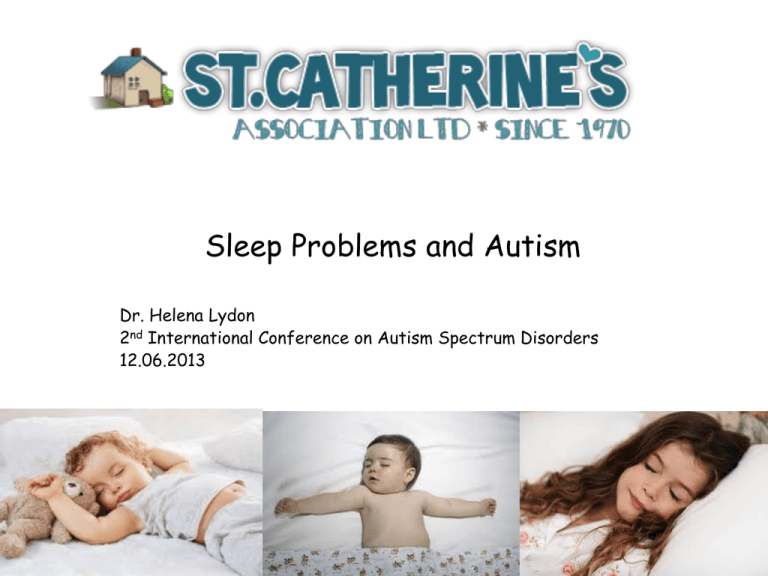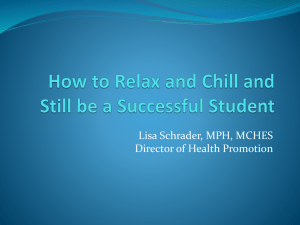Helena Lydon - Conference.ie
advertisement

Sleep Problems and Autism Dr. Helena Lydon 2nd International Conference on Autism Spectrum Disorders 12.06.2013 Sleep Problems and Autism • Autism is characterised by impairments including social interaction, communication deficits, and restricted, repetitive behaviours. • Secondary Behavioural difficulties often coexist: tantrums, tactile hypersensitivity, selfinjury, destructive behaviour, cognitive impairment, and sleep problems. • Parental surveys indicate a 50-80% prevalence of sleep problems in children with ADS (Richdale & Schreck, 2009; Polimeni, Richdale & Francis, 2005). Age and Sleep Problems • While evidence exits for some improvements with age, older children still exhibited sleep problems • Honomichl et al. (2002) found that parents of older children report more sleep problems • Doo and Wing (2006) reported that the onset of Pervasive Developmental Disorder signs before age 2 years was predictive of significant sleep problems. Types of Sleep problems • Sleep Problems – – – – – – Sleep Onset and Maintenance Early Morning Awakenings Unwillingness to fall asleep in own bed Restless sleep Nightmares/ night terrors Excessive daytime sleepiness Effects of Poor Sleep • Sleep problems have been found to adversely affect : – Cognitive functioning (Taylor, Schreck, & Mulick, 2012) – Daytime/adaptive behaviour (Taylor, Schreck, & Mulick, 2012) – Increases aggression & irritability (Malow et al., 2006) • Children’s sleep Problems can lead to: – Maternal malaise and depression – Parental sleep problems – Parental relationships with each other and with their children. Cause of Sleep Disturbances in children with autism • The exact cause(s) of sleep problems is not yet known, however, many researchers have put forward a variety of factors – – – – – Serotonin and Melatonin Sensory Social and Communication difficulties Anxiety Environmental Factors Treatments for sleep problems • • • • • Social Stories (Moore, 2004) Light therapy Chronotherapy (Piazza et al., 1998) Medication Behavioural Interventions Behavioural Treatments of Sleep Problems • Behavioural Interventions have been shown to be effective in treating daytime behavioural difficulties in children with autism • In addition Behavioural Interventions have been shown to be effective in treating sleep problems. • It is evident from parental reports that behavioural interventions are viewed as preferable to medication (Richdale, 1999). Assessment of Sleep Problems • Falling asleep is the target behaviour. • Influenced by ancestral history and our present culture. • Influenced by past and present events in one’s sleep environment. – Motivated (or demotivated) – Reliance on environmental cues Assessment Tools • Children’s Sleep Habit Questionnaire (Owens, 2000) http://www.gse.uci.edu/childcare/pdf/questionnaire_interview/Childrens %20Sleep%20Habits%20Questionnaire.pdf • Sleep Assessment and Treatment Tool (SATT) (Hanley, 2005) http://www.ontaba.org/pdf/conference_2011/sleep_asses sment_and_treatment_tool.pdf • Sleep Diary Sleep Diary Keys to success • It is recommended that this programme be implemented when the families/staff are able to fulfil all the requirements to facilitate the introduction of the programme. • E.g. Holiday periods Getting the motivation for Sleep • Recognition of age-appropriate day and night sleep amounts The Forbidden Zone •Recognise your child's current sleep phase and capitalise on sleep pressure when beginning to treat any sleep problem Adpated from: Solve Your Child’s Sleep Problems, Richard Ferber, Simon & Schuster, 2006 Bedtime Routines • Children with autism can have unusual and problematic sleep routines • Regularizing bedtime routines can lead to improved sleep • Develop a bedtime routine that is as pleasant, relaxed, and as consistent as possible. • Consider a picture schedule depicting the night time routine. Bedtime Routine • It is recommended that a bedtime routine be established and carried out nightly the half hour before bedtime. It is important to practice the routine consistently for 3 weeks for the routine to become associated with sleep. • Encourage calm activities before bedtime. Cease exciting activities about an hour before bedtime. Avoid (a) watching TV during this time, (b) any activities which may cause conflict, and (c) extending the time for the bedtime routine. Behavioural Treatments of Sleep Problems • Extinction (Williams, 1959) – sleep onset problems maintained by parental attention. – and effective treatment for sleep onset and maintenance difficulties – One obstacles is that parents frequently find it difficult to ignore the cries of a child for an extended period of time • Graduated extinction (Rolider and Van Houten, 1984) – decrease in the child’s crying – Also found to be effective at reducing night waking • Faded Bedtime Procedure with response cost (Piazza and Fisher, 1991). – effective at reducing sleep onset latency and night waking. • Piazza et al. (1997) conducted a comparison faded bedtime with response cost and bedtime scheduling. – Bedtime scheduling produced minimal improvements – Faded Bedtime with response cost was more successful at reducing sleep problems • Scheduled Awakening/ Sleep Restriction (Durand, 1998; Durand & Mindell, 1999) – Have successfully reduced night waking – Durand and Christodulu (2003) eliminated bedtime disturbances and reduced nighttime awakenings – Christodulu and Durand (2004) combined bedtime routine and sleep restriction to successfully eliminate bedtime disturbances and reduce night awakenings in children – This intervention does not rely on the withdrawal of parental attention – Used in conjunction with fading Case Study 1 Age: Diagnosis: 18 years 8 months Autism Moderate to Severe Learning Disability Query Tourette Syndrome Sleep Problem: Sleep Maintenance Early morning awakenings Sleep Problem • The child typically wakes early in the morning between 4:00am and 5:00am. When he wakes he typically engages in shouting, banging his chest, pull his stomach, which can disrupt and wake other service users. Occasionally stays in bed and falls back to sleep. However, on other occasions gets up and he wants to wet clothes. He does this by placing his clothes in the bath, following this typically becomes vocal. The behaviour of putting clothes in the sink or bath, and splashing in the toilet can occur during the day. • Staff report that the early morning awakening used to occur approximately once per week, but now occur 4-5 times per week. If the child wakes at 4am he is awake for the day. Staff encourage him to return to bed. They place fresh sheets on the bed and put the covers back on him. Staff report that tucking him in sometimes helps. • Staff report that if child is re-directed back to his room, and he does not return to bed he can defecate on the floor. This behaviour has been observed on three occasions in the last 6 months. Staff also report that he does experience sexual arousal and query whether if he masturbated if he wakes and for this reason he may be taking off his clothes and the bed linen. Hours of Sleep Number of Hours 10 8 6 4 2 01 /0 2 03 /2 0 /0 12 2 05 /2 0 /0 12 2 07 /2 0 /0 12 2 09 /2 0 /0 12 2 11 /2 0 /0 12 2 13 /2 0 /0 12 2 15 /2 0 /0 12 2 17 /2 0 /0 12 2 19 /2 0 /0 12 2 21 /2 0 /0 12 2 23 /2 0 /0 12 2 25 /2 0 /0 12 2 27 /2 0 /0 12 2/ 20 12 0 Days of wakes Waking TimeTime Ross 8 7 Time (am) 6 5 4 3 2 1 0 1 3 5 7 9 11 13 15 Days 17 19 21 23 25 27 Present Sleep Schedule • Typically goes to bed 10:3011:00. • He falls asleep within 20minutes. • Wakes in the morning anytime between 5:00am and 7:30 am. • Sleep duration varies from 5 -8 hrs. Present Bedtime Routine • Supper • Watches TV • Massage hands and feet • brushes teeth, • Lies in bed, • Lights off/door closed • Sleep (Normally goes to sleep, might on occasion shout a few times for 10-15 minutes). Behavioural Treatment Package • Environmental Accommodations – – – – Visual timer Laundry basket Sleeping blanket Social story • Sleep Restriction • Faded awakenings • Reactive Strategy – Procedure for night time awakenings • Skills Teaching ENVIRONMENTAL ACCOMODATIONS • A visual timer. The clock has two settings night and day and change colour to indicate that it is time to sleep or time to get up. • A laundry basket placed in bedroom. • A sleeping blanket/bag will be available in bedroom if he removes his sheet due to it being wet. • A Social Stories to provide information about expectations about appropriate behaviour. To inform him of appropriate behaviour at night and if he wakes early. The social story will address key aspects of appropriate behaviours such when to stay in bed and when to get up. It will also address if his clothes are wet that he can put them in a laundry basket and return to bed. DIRECT INTERVENTION Sleep Restriction: • Child to be woken 15-30 minutes before the time he would spontaneously awaken. E.g. Wakes regularly between 5:00am and 7:30am. Therefore, will be awoken at 4:45am and shown that his visual clock shows it is time to get up. Fading • A time fading procedure will also be used to gradually change the time the child gets up at. E.g. Following two successive nights at 4:45 awakenings the time will gradually be adjusted to fade awakening to his target awakening time of 7:00am. SKILLS TEACHING • Child to be taught that if his sheets are wet that he places them in a laundry basket, and changes his clothes and returns to bed. • Also Child should be taught to stay in bed until his visual clock indicates that it is time to get up. To ensure this it may be important to identify an activity that the child can engage in such as listening to music on headphones. Alternatively preferred items and/or activities will be put in place to enable the child to self occupy if he wakes early. REACTIVE STRATIGIES Procedure for night-time awakenings or early morning awakenings • If the child wakes at night remind him that it is necessary to wait until the clock changes colour. As the child has a history of escalating his behaviour in response to being asked to return to his room, staff are to reset the clock to change to “time to get up” after 5 minutes. If the child return to the bed for these 5 minutes staff should praise child for getting up when the clock changed. Results Hours of Sleep Baseline 10 Intervention Hours 8 6 4 2 H H H 0 1 3 5 7 9 11 13 15 17 19 21 23 25 27 29 31 33 35 37 39 41 43 45 47 49 51 Time 1stDays woke Baseline Intervention Time in Hours 10 8 6 4 2 H H H 0 1 3 5 7 9 11 13 15 17 19 21 23 25 27 29 31 33 35 37 39 41 43 45 47 49 51 Days H = Nights at Home Case Study 2 Age: Diagnosis: 5 years 9 months Autism Moderate Learning Disability Sleep Problem: Sleep Onset Difficulties getting up in the morning Behavioural Treatment Package • Environmental Changes – – – – – – – Visual Timer Night Light Door closed Toys to be stored away Bedtime Routine Door to be left open until he has fallen asleep Staff to sit inside the door (their back facing the bed) • Faded Bedtime • Reactive Strategy – Procedure for Night time awakenings – revised • Wake-Up procedure Intervention 1 Intervention 2 Environmental Changes • • • • Visual Timer Bedtime routine A night light should be placed in the child’s room The bedroom door should be closed at night after bedtime • Door to remain open until after he has fallen asleep • Staff to sit inside the door with their back to the bed • Access to toys and or activities within the bedroom should be limited. Toys and/or activities will be put in a chest or box and stored out of reach at night time. Faded Bedtime • Child was put to bed 30 minutes later than he typically falls asleep. – Current bedtime = 11:00pm, – New Bedtime = 11:30pm. – Bedtime routine to be completed in the half hour before bedtime. • Child to sleep 10 to 11 hours. Note: As child is going to bed at 11:30, allow the child to sleep for 10-11 hours. e.g. The first two nights allow the child to sleep until 10:30am. If the child wakes earlier than this time document the waking time and follow wake up procedure • The criteria set for fading bedtime: if child falls asleep within 15 minutes of going to bed for two consecutive nights, then bedtime can be moved forward a half hour the following night. • It is important to stick to bedtime and waking times – as oversleeping one day may lead to difficulty going to bed that night. Night Time awakening • If child gets up from his bed , staff should take child back to bed immediately without making eye contact, cuddling, talking to or ‘telling him off’. • Only words to be spoken are “Its bedtime” • It is recommended that he is not allowed to run about the house. To avoid this staff should stay at his door until he has settled and fallen asleep. • Remover soother if he wakes in at night. • Do not sit on the bed • Do not read extra stories Wake-Up Procedure A visual timer was used to teach the child when it is time to sleep and when it is time to get up. A picture based story was used to teach the child what each colour symbolises and what happens when the clock is ringing and what happens when it is not ringing. Example: Blue = going to bed Blue and stars = stay in bed/ bedroom Yellow = time to get up • • • It is recommended that the story have key phrases such as “time for bed”, “its sleep time” and its “time to get up”. Staff should refer to these at the relevant stages. In the morning when the child is being woken, the sound of clock should be brought to his attention and he should be reminded its time to get up. Small changes in the environment might help him to wake in a positive mood, such as drawing the curtains a small portion at a time, or playing preferred music at a low level. Results Bedtime Intervention 1 12:00 Intervention 2 Time Baseline 10:48 09:36 08:24 1 4 7 10 13 16 19 22 25 28 31 34 37 40 43 46 49 52 55 58 61 64 43 49 55 64 Days Duration in Minutes Duration to Sleep 150 Intervention 1 Intervention 2 Baseline 100 50 0 1 4 7 10 13 16 19 22 25 28 31 34 Days 37 40 46 52 58 61 Thank you. Questions or Queries?






